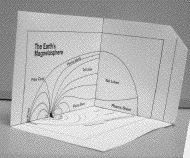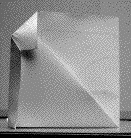This is a new version of a 3-dimensional paper model of the Earth's magnetosphere, featuring three perpendicular cuts through it and showing its main regions. The result is a hollow rectangular corner, inside which the regions are traced.
 "The cuts are
"The cuts are
- Along the equatorial plane, separating the northern half from the southern one
- Along the noon-midnight plane, separating eastern and western halves
- A dawn-dusk cut across the nightside magnetotail, about 20 Earth radii away.
In cuts (1) and (3), drawn lines outline boundaries of labeled regions; in region (2) they follow magnetic field lines (some of which also follow boundaries).
The model is easily constructed, but to understand it, you better read the web pages of "The Exploration of the Earth's Magnetosphere." The Sun in this model is on the left, where the solar wind compresses the magnetic field lines of the Earth (also forming a shock front some distance further sunward). On the night side the magnetic field stretches more than 10 times further than this model reaches.
This model has been modified from an older version, and requires no cutting (as the earlier one does). It too uses regular paper and can be duplicated on a Xerox machine, although stiff "construction paper" will produce better-looking models (and may let you skip step #9)0. If this update does not work, you can always go back to the old version--but in that case, please also let me know what you tried that did not work!
Instructions for producing the master copy
- Go to your web browser and open
http://www.phy6.org/wfoldF.jpg, an image file.
- Copy the file onto your computer (note what your screen shows may be a scaled version: the image itself measures 1697 by 2293 pixels). Give it some name of your own choice, e.g. magmod.jpg
- Open the copy with your image software. If you are lucky, you can print it full-page size (it did so using Preview 3.0 on Macintosh OS 10.4). If not, modify the scale until it does.
- Print 1-3 master copies. From them you can make actual copies, as many as you wish.
Instructions to the user (e.g. student)
- Put your copy on a hard surface (a clipboard is fine) and with a straight ruler, guide a ballpoint pen to retrace on it 3 main lines. The retracing should continue to the edges of the page, beyond the printed parts of the line. You retrace:
- The long axis (passing the words "subsolar point")
- The short axis, the one with "tail lobes" repeated on both sides
- The diagonal line in the "empty quarter" but only on the "empty" side, stay off the print.
The purpose of this is NOT to mark the paper (your pen may even be empty of ink!) but to SCORE it, forming grooves along which the paper easily folds.
- Fold the page along lines (1) and (2) (not the diagonal line!) making a sharp crease. Then reverse the folds and crease them the other way.
- Also fold and crease the diagonal line (3), but only on the side of the "empty quarter". Don't let the crease extend into the printed part.
- At this point, if students wish, they can lightly color some regions of the image.
- Close the fold at the diagonal line. The three cross-sections of the magnetosphere should now form a hollow rectangular corner.

- Lift the triangular fold created in the previous step, until it is behind the cross section of the tail (containing only the words "tail lobes" and "plasma sheet"). See picture shown here)
- Take the cross section of the tail against which you lifted the triangular fold, and bend back a triangular corner at the top, large enough to hold the fold in place (see picture here). Crease it to hold in place.
- (Optional) Fold over and crease a strip of the vertical edge, extending to the folded corner (along the left side in the picture here). This helps keep the edge of the model stiff and upright. The exact width of the strip is not critical.
Your model is now ready!
|
 "The cuts are
"The cuts are
